Matter and Materials: Identify and apply knowledge of organic molecules in everyday life and industrial context
Unit 1: Organic Molecules
Emma Harrage
Unit outcomes
By the end of this unit you will be able to:
- Identify organic molecular structures with functional groups, saturated and unsaturated structures.
Introduction
Parts of the text in this unit were sourced from Siyavula Physical Science Gr 12 Learner’s Book, Chapter 4, released under a CC-BY licence.
In this unit you will learn about organic molecules. Organic molecules contain carbon and hydrogen. They usually form long chain structures which are fuels, alcohols, and plastics. Most organic molecules used are distilled from crude oil.
What are organic molecules?
Organic chemistry is the branch of chemistry that deals with organic molecules. An is one which contains carbon, although not all compounds that contain carbon are organic molecules. For example, pure carbon compounds such as diamond and graphite are not organic compounds.
Organic molecules can range in size from simple molecules to complex structures containing thousands of atoms! Although carbon is present in all organic compounds, other elements such as hydrogen (H), oxygen (O), nitrogen (N), sulfur (S) and phosphorus (P) are also common in these molecules.
Organic compounds are very important in daily life, and they range from being simple to extremely complex. Organic molecules make up a big part of our own bodies, they are in the food we eat and in the clothes we wear. Organic compounds are also used to make products such as medicines, plastics, washing powders, dyes, along with an extensive list of other items. There are millions of organic compounds found in nature, as well as millions of synthetic manufactured organic compounds.
Organic structure
Carbon has a number of unique properties which influence how it behaves and how it bonds with other atoms:
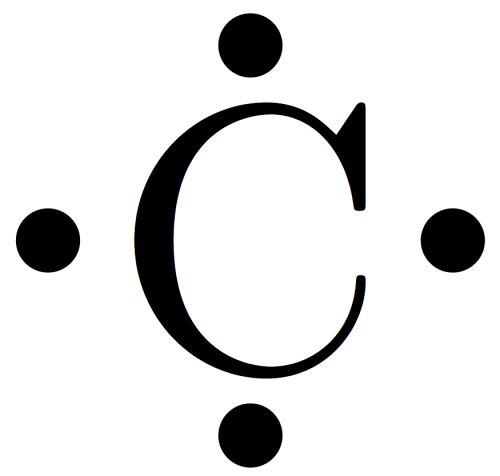
Because of the number of bonds that carbon can form with other atoms, organic compounds can be very complex. Carbon can form bonds with other carbon atoms to form single, double, or triple covalent bonds. Carbon can also form bonds with other atoms such has hydrogen, oxygen, nitrogen, and the halogens.
Carbon can bond to form straight chain, branched, and cyclic molecules. Because of this, long chain structures can form. This is known as catenation – the bonding of atoms of the same element into longer chains. These chains can either be unbranched (see figure 2) or branched (see figure 3) and can contain single carbon-carbon bonds only, or double and triple carbon-carbon bonds as well.


Most of the bonds that carbon forms with other atoms are covalent. Think, for example, of a C−C bond. The difference in electronegativity between the two atoms is zero, so this is a pure covalent bond. In the case of a C−H bond, the difference in electronegativity between carbon ([latex]\scriptsize \displaystyle 2,5[/latex]) and hydrogen ([latex]\scriptsize \displaystyle 2,2[/latex]) is so small that C−H bonds are almost purely covalent. The result of this is that most organic compounds are non-polar. This affects some of the properties of organic compounds.
The formulae of organic compounds
There are five ways of representing organic compounds:
- Structural formula: The structural formula of an organic compound shows every bond between every atom in the molecule. Each bond is represented by a line. The structural formulae of 2-methylpropane and butane.
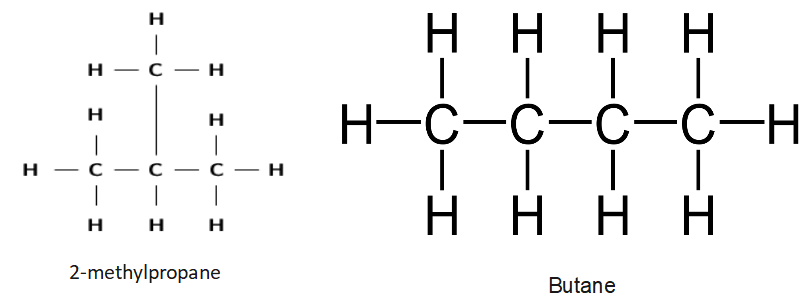
Figure 4: The different structures of [latex]\scriptsize \displaystyle {{\text{C}}_{\text{4}}}{{\text{H}}_{{\text{10}}}}[/latex] 
Figure 5: Molecules are not two-dimensional, here are a few examples of different ways to represent methane ([latex]\scriptsize \displaystyle \text{C}{{\text{H}}_{4}}[/latex]) and ethane ([latex]\scriptsize \displaystyle {{\text{C}}_{\text{2}}}{{\text{H}}_{\text{6}}}[/latex]) - Semi-structural formula: It is possible to understand the structure of an organic molecule without writing out all the carbon-hydrogen bonds.

Figure 6: This way of writing a structure is called a semi-structural formula; (a) is 2-methylpropane and (b) is butane - Condensed structural formula: It is also possible to represent a molecule without showing any bonds between atoms at all. As for a semi-structural representation, the carbon atoms are grouped with the hydrogen atoms bonded directly to each one. The bonds between these groups are not shown. Branched or substituent groups are shown in brackets after the carbon atom to which they are bonded.
.
[latex]\scriptsize \displaystyle \text{C}{{\text{H}}_{\text{3}}}\text{CH(C}{{\text{H}}_{\text{3}}}\text{)C}{{\text{H}}_{\text{3}}}[/latex] – 2-methylpropane (the brackets around ([latex]\scriptsize \text{C}{{\text{H}}_{3}}[/latex]) represent the branched section of the structural formula
[latex]\scriptsize \text{C}{{\text{H}}_{\text{3}}}\text{C}{{\text{H}}_{\text{2}}}\text{C}{{\text{H}}_{\text{2}}}\text{C}{{\text{H}}_{\text{3}}}[/latex] – butane
Butane can also be written in a more condensed way:
[latex]\scriptsize \text{C}{{\text{H}}_{\text{3}}}{{\text{(C}{{\text{H}}_{\text{2}}}\text{)}}_{\text{2}}}\text{C}{{\text{H}}_{\text{3}}}[/latex] - Molecular formula: This formula shows the actual number of each type of atom. The number of each atom is written as a subscript after the atomic symbol. The molecular formula of 2-methylpropane is: [latex]\scriptsize \displaystyle {{\text{C}}_{\text{4}}}{{\text{H}}_{{\text{10}}}}[/latex]. This means that each molecule of 2-methylpropane consists of four carbon atoms and ten hydrogen atoms. The molecular formula of butane is also [latex]\scriptsize \displaystyle {{\text{C}}_{\text{4}}}{{\text{H}}_{{\text{10}}}}[/latex]. The molecular formula gives no structural information about the compound.
Exercise 1.1
- For each of the following, give the structural formula and the molecular formula.
- [latex]\scriptsize \displaystyle \text{C}{{\text{H}}_{\text{3}}}\text{C}{{\text{H}}_{\text{2}}}\text{C}{{\text{H}}_{\text{3}}}[/latex]
- [latex]\scriptsize \displaystyle \text{C}{{\text{H}}_{\text{3}}}\text{C}{{\text{H}}_{\text{2}}}\text{CH}\left( {\text{C}{{\text{H}}_{\text{3}}}} \right)\text{C}{{\text{H}}_{\text{3}}}[/latex]
- For each of the following organic compounds, give the condensed structural formula and the molecular formula.

The full solutions are at the end of the unit.
Functional groups
The way in which a compound will react is determined by a particular characteristic of a group of atoms and the way they are bonded (e.g. double C−C bond, C−OH group). This is called the . This group is important in determining how a compound will react. The same functional group will undergo the same or similar chemical reaction(s) regardless of the size of the molecule it is a part of. Molecules can have more than one functional group.
In one group of organic compounds, called the hydrocarbons, the single, double, and triple bonds between carbon atoms give rise to the alkanes, alkenes, and alkynes, respectively. The double carbon-carbon bonds (in the alkenes) and triple carbon-carbon bonds (in the alkynes) are examples of functional groups.
In another group of organic compounds, called the alcohols, an oxygen and a hydrogen atom are bonded to each other to form the functional group (in other words an alcohol has an OH in it). All alcohols will contain an oxygen and a hydrogen atom bonded together and attached to the carbon chain.

There are some important points to note as we discuss functional groups:
The beginning of a compound name (prefix) comes from the number of carbons in the longest chain:
| Prefix | Number of carbon atoms |
| meth- | [latex]\scriptsize 1[/latex] |
| eth- | [latex]\scriptsize 2[/latex] |
| prop- | [latex]\scriptsize 3[/latex] |
| but- | [latex]\scriptsize 4[/latex] |
The end of a compound name (suffix) comes from the functional group, e.g. an alkane has the suffix -ane.
Note
The term prefix means a word, letter, or number placed before another.
The word suffix means a letter or a group of letters added to the end of a word.
Saturated and unsaturated hydrocarbons
Hydrocarbons that contain only single bonds are and are called saturated hydrocarbons because each carbon atom is bonded to as many hydrogen atoms as possible. Figure 8 shows a molecule of ethane, which is a saturated hydrocarbon.
Hydrocarbons that contain double or triple bonds are and are called unsaturated hydrocarbons because they do not contain the maximum number of hydrogen atoms.
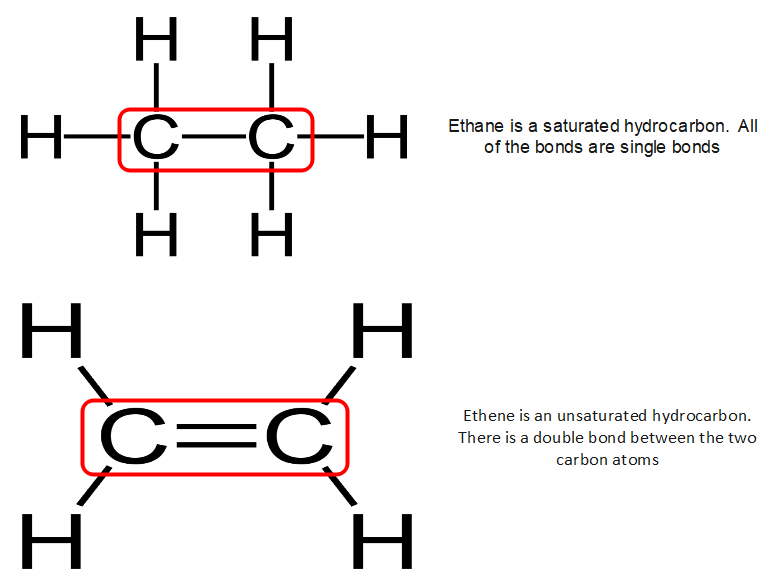
Figure 8 shows molecules of ethane and ethene. If you compare the number of carbon and hydrogen atoms in a molecule of ethane and a molecule of ethene, you will see that the number of hydrogen atoms in ethene is less than the number of hydrogen atoms in ethane even though they both contain two carbon atoms. For an unsaturated hydrocarbon compound to become saturated, one of the two (or three) bonds in a double (or triple) bond must be broken, and additional atoms added.
Hydrocarbons
The that we are going to look at are called aliphatic compounds. The aliphatic compounds are divided into acyclic compounds (chain structures) and cyclic compounds (ring structures). The chain structures are further divided into structures that contain only single bonds (alkanes), those that contain at least one double bond (alkenes) and those that contain at least one triple bond (alkynes).
Cyclic compounds (which will not be covered in this book) include structures such as a cyclopentane ring, which is found in insulating foam and in appliances such as fridges and freezers.

The alkanes
The alkanes are the simplest organic compounds, which are composed of carbon and hydrogen atoms only. Hydrocarbons with only carbon-to-carbon single bonds (C–C), and existing as a continuous chain of carbon atoms bonded to hydrogen atoms only, are called alkanes (or saturated hydrocarbons).

Methane ([latex]\scriptsize \displaystyle \text{C}{{\text{H}}_{\text{4}}}[/latex]), ethane ([latex]\scriptsize \displaystyle {{\text{C}}_{\text{2}}}{{\text{H}}_{\text{6}}}[/latex]), and propane ([latex]\scriptsize \displaystyle {{\text{C}}_{\text{3}}}{{\text{H}}_{\text{8}}}[/latex]) are the beginning of a series of compounds in which any two members in a sequence differ by one carbon atom and two hydrogen atoms—namely, a [latex]\scriptsize \displaystyle \text{C}{{\text{H}}_{2}}[/latex] unit. Any family of compounds in which adjacent members differ from each other by a definite factor (here a [latex]\scriptsize \displaystyle \text{C}{{\text{H}}_{2}}[/latex] group) is called a . The members of such a series have properties that vary in a regular and predictable manner. The principle of homology gives organisation to organic chemistry in much the same way that the periodic table gives organisation to inorganic chemistry.

| Name | Molecular formula ([latex]\scriptsize \displaystyle {{\text{C}}_{\text{n}}}{{\text{H}}_{\text{2}}}_{\text{n}}\text{+2}[/latex]) | Condensed structural formula |
| Methane | [latex]\scriptsize \displaystyle \text{C}{{\text{H}}_{\text{4}}}[/latex] | [latex]\scriptsize \displaystyle \text{C}{{\text{H}}_{\text{4}}}[/latex] |
| Ethane | [latex]\scriptsize \displaystyle {{\text{C}}_{\text{2}}}{{\text{H}}_{\text{6}}}[/latex] | [latex]\scriptsize \text{C}{{\text{H}}_{\text{3}}}\text{C}{{\text{H}}_{\text{3}}}[/latex] |
| Propane | [latex]\scriptsize \displaystyle {{\text{C}}_{\text{3}}}{{\text{H}}_{\text{8}}}[/latex] | [latex]\scriptsize \text{C}{{\text{H}}_{\text{3}}}\text{C}{{\text{H}}_{2}}\text{C}{{\text{H}}_{\text{3}}}[/latex] |
| Butane | [latex]\scriptsize \displaystyle {{\text{C}}_{4}}{{\text{H}}_{{10}}}[/latex] | [latex]\scriptsize \text{C}{{\text{H}}_{\text{3}}}\text{C}{{\text{H}}_{2}}\text{C}{{\text{H}}_{2}}\text{C}{{\text{H}}_{\text{3}}}[/latex] |
| Pentane | [latex]\scriptsize \displaystyle {{\text{C}}_{5}}{{\text{H}}_{{12}}}[/latex] | [latex]\scriptsize \text{C}{{\text{H}}_{\text{3}}}\text{C}{{\text{H}}_{2}}\text{C}{{\text{H}}_{2}}\text{C}{{\text{H}}_{2}}\text{C}{{\text{H}}_{\text{3}}}[/latex] |
| Hexane | [latex]\scriptsize \displaystyle {{\text{C}}_{6}}{{\text{H}}_{{\text{1}4}}}[/latex] | [latex]\scriptsize \text{C}{{\text{H}}_{\text{3}}}\text{C}{{\text{H}}_{2}}\text{C}{{\text{H}}_{2}}\text{C}{{\text{H}}_{2}}\text{C}{{\text{H}}_{2}}\text{C}{{\text{H}}_{\text{3}}}[/latex] |
| Heptane | [latex]\scriptsize \displaystyle {{\text{C}}_{7}}{{\text{H}}_{{16}}}[/latex] | [latex]\scriptsize \text{C}{{\text{H}}_{\text{3}}}\text{C}{{\text{H}}_{2}}\text{C}{{\text{H}}_{2}}\text{C}{{\text{H}}_{2}}\text{C}{{\text{H}}_{2}}\text{C}{{\text{H}}_{2}}\text{C}{{\text{H}}_{\text{3}}}[/latex] |
The general formula for alkanes is [latex]\scriptsize \displaystyle {{\text{C}}_{\text{n}}}{{\text{H}}_{\text{2}}}_{\text{n}}\text{+2}[/latex]. Using this formula, we can write a molecular formula for any alkane with a given number of carbon atoms. For example, an alkane with eight carbon atoms has the molecular formula [latex]\scriptsize \displaystyle {{\text{C}}_{\text{8}}}{{\text{H}}_{{\left( {\text{2 }\!\!\times\!\!\text{ 8}} \right)\text{ + 2 }}}}\text{= }{{\text{C}}_{\text{8}}}{{\text{H}}_{{\text{18}}}}[/latex] which is called octane.
The alkanes are the most important source of fuel in the world and are used extensively in the chemical industry. Alkanes that contain four or less carbon atoms are gases (e.g. methane and ethane). Longer chains are liquid fuels e.g. octane, which is a key component of petrol and very long chains are solids.
The alkenes and alkynes
Alkenes are hydrocarbons with carbon-to-carbon double bonds ([latex]\scriptsize \displaystyle {{\text{R}}_{\text{2}}}\text{C=C}{{\text{R}}_{\text{2}}}[/latex]) and alkynes are hydrocarbons with carbon-to-carbon triple bonds ([latex]\scriptsize \displaystyle \text{R--C}\equiv \text{C--R}[/latex]). Collectively, they are called unsaturated hydrocarbons because they have fewer hydrogen atoms than does an alkane with the same number of carbon atoms.

The alkenes also form a homologous series. They have the general formula [latex]\scriptsize \displaystyle {{\text{C}}_{\text{n}}}{{\text{H}}_{{\text{2n}}}}[/latex]. Alkenes end with the suffix -ene, but they can have two double bonds and then the suffix is -diene.
Ethene and propene are most often called by their common names, ethylene and propylene, respectively.

| Name | Molecular formula | Condensed structural formula |
| Ethene | [latex]\scriptsize {{\text{C}}_{\text{2}}}{{\text{H}}_{\text{4}}}[/latex] | [latex]\scriptsize \displaystyle \text{C}{{\text{H}}_{\text{2}}}\text{=C}{{\text{H}}_{\text{2}}}[/latex] |
| Propene | [latex]\scriptsize {{\text{C}}_{\text{3}}}{{\text{H}}_{\text{6}}}[/latex] | [latex]\scriptsize \displaystyle \text{C}{{\text{H}}_{\text{2}}}\text{=CHC}{{\text{H}}_{\text{3}}}[/latex] |
| 1-butene | [latex]\scriptsize {{\text{C}}_{\text{4}}}{{\text{H}}_{\text{8}}}[/latex] | [latex]\scriptsize \displaystyle \text{C}{{\text{H}}_{\text{2}}}\text{=CHC}{{\text{H}}_{\text{2}}}\text{C}{{\text{H}}_{\text{3}}}[/latex] |
| 1-pentene | [latex]\scriptsize {{\text{C}}_{\text{5}}}{{\text{H}}_{{\text{10}}}}[/latex] | [latex]\scriptsize \displaystyle \text{C}{{\text{H}}_{\text{2}}}\text{=CH(C}{{\text{H}}_{\text{2}}}{{\text{)}}_{2}}\text{C}{{\text{H}}_{\text{3}}}[/latex] |
| 1-hexene | [latex]\scriptsize {{\text{C}}_{6}}{{\text{H}}_{{\text{12}}}}[/latex] | [latex]\scriptsize \displaystyle \text{C}{{\text{H}}_{\text{2}}}\text{=CH(C}{{\text{H}}_{\text{2}}}{{\text{)}}_{3}}\text{C}{{\text{H}}_{\text{3}}}[/latex] |
| 1-heptene | [latex]\scriptsize {{\text{C}}_{7}}{{\text{H}}_{{\text{14}}}}[/latex] | [latex]\scriptsize \displaystyle \text{C}{{\text{H}}_{\text{2}}}\text{=CH(C}{{\text{H}}_{\text{2}}}{{\text{)}}_{4}}\text{C}{{\text{H}}_{\text{3}}}[/latex] |
| 1-octene | [latex]\scriptsize {{\text{C}}_{8}}{{\text{H}}_{{\text{16}}}}[/latex] | [latex]\scriptsize \displaystyle \text{C}{{\text{H}}_{\text{2}}}\text{=CH(C}{{\text{H}}_{\text{2}}}{{\text{)}}_{5}}\text{C}{{\text{H}}_{\text{3}}}[/latex] |
The alkenes are more reactive than the alkanes because they are unsaturated. As with the alkanes, compounds that have four or less carbon atoms are gases at room temperature. Those with five or more carbon atoms are liquids and very long chains will be solids.
Ethene is a chemical compound used in plants to stimulate the ripening of fruits and the opening of flowers. Propene is an important compound in the petrochemicals industry. It is used to make polypropylene and is also used as a fuel gas for other industrial processes.
Ethylene is a major commercial chemical. More than half of ethylene goes into the manufacture of polyethylene, one of the most familiar plastics. Propylene is also an important industrial chemical. It is converted to plastics, isopropyl alcohol, and a variety of other products.
The alkynes
In alkynes there must be at least one triple bond between two of the carbon atoms. They are unsaturated compounds and are therefore more reactive than alkanes. Their general formula is [latex]\scriptsize \displaystyle {{\text{C}}_{\text{n}}}{{\text{H}}_{{\text{2n}}}}_{{\text{-2}}}[/latex]. For example, 1-butyne has the molecular formula [latex]\scriptsize \displaystyle {{\text{C}}_{\text{4}}}{{\text{H}}_{\text{6}}}[/latex]. The simplest alkyne is ethyne also known as acetylene. Many of the alkynes are used to synthesise other chemical products.
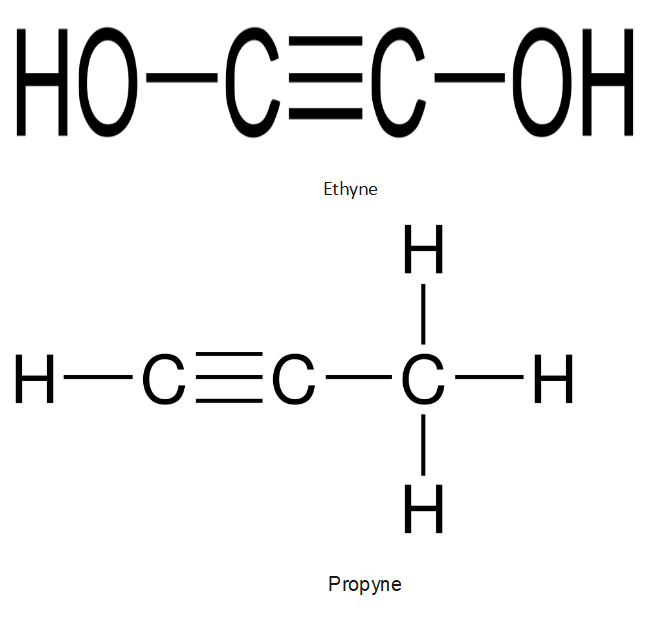
Acetylene is the industrial name for the organic compound ethyne. The raw materials that are needed to make acetylene are calcium carbonate and coal. An important use of acetylene is in oxyacetylene gas welding. The fuel gas burns with oxygen in a torch. Because the combustion of alkenes and alkynes is exothermic an incredibly high heat is produced, which is hot enough to melt metal.
Exercise 1.2
- Briefly identify the important distinctions between an alkene and an alkane.
- Briefly identify the important distinctions between a saturated hydrocarbon and an unsaturated hydrocarbon.
- Which hydrocarbon series is the least reactive? Explain why.
The full solutions are at the end of the unit.
The alcohols
Alcohols are an important class of compounds containing the hydroxyl functional group. There are three classes of alcohols: primary, secondary, and tertiary.
An alcohol is any organic compound where there is a hydroxyl functional group (−OH) bound to a carbon atom. The general formula for a simple alcohol is [latex]\scriptsize \displaystyle {{\text{C}}_{\text{n}}}{{\text{H}}_{{\text{2n}}}}_{{\text{+1}}}\text{OH}[/latex]. Alcohols have the suffix -ol.
The simplest and most used alcohols are methanol and ethanol.

There are three types of alcohol molecules. The type of alcohol is determined by the position of the hydroxyl functional group.
The alcohols share several properties because of the hydroxyl group. The hydroxyl group affects the solubility of the alcohols (in water). Those with shorter carbon chains are generally more soluble, and those with longer chains are less soluble. The strong hydrogen bond (intermolecular force) the hydroxyl groups in adjacent alcohol molecules gives alcohols a higher melting point and boiling point than the hydrocarbons (which have weak London forces).
A primary alcohol is one in which the hydroxyl group (–OH) is attached to a carbon atom with at least two hydrogen atoms. This will only occur when the hydroxyl group is at the end of the molecule chain.
A secondary alcohol is one in which the hydroxyl group (−OH) is attached to a carbon with only one hydrogen atom attached. This can happen somewhere in the middle of a carbon chain.
A tertiary alcohol is one in which the hydroxyl group is attached to a carbon with no hydrogen atoms attached. This will normally mean that the hydroxyl group is joined to the same carbon atom as a branch.
Note
When naming organic compounds, the position of the number in the name shows the position of the functional group. For example, propan-1-ol shows that the hydroxyl group is at the end of the carbon chain, whilst propan-2-ol shows that the hydroxyl group is attached to the second carbon in the chain.
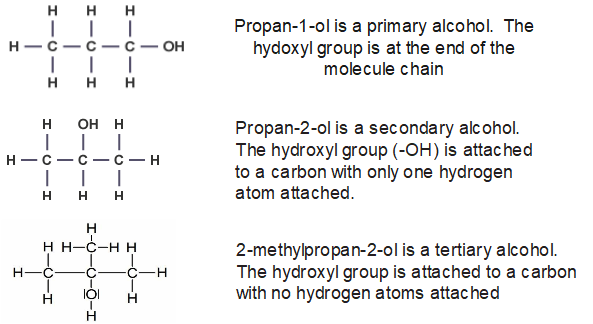
Alcohols can have more than one hydroxyl group; alcohols with two hydroxyl groups are called diols and alcohols with three hydroxyl groups are called triols.
The alcohols have several different uses:
- Methylated spirits is ethanol with methanol added. Methanol is toxic. If ingested it forms formic acid or formate salts, which damage the central nervous system and can cause blindness, coma, or death.
- All alcohols are toxic, but in low concentrations ethanol can be used in alcoholic drinks. Ethanol is the only alcohol used in alcoholic drinks and it is used as an industrial solvent. It is also used as a solvent in medical drugs, perfumes and as an antiseptic.
- Methanol and ethanol can both be used as a fuel, and they burn more cleanly than petrol or diesel.
Alkyl halides
Alkyl halides are hydrocarbons with one hydrogen atom replaced by a halogen atom (F, Cl, Br, I). The alkyl is due to the fact that a hydrocarbon branched group has the suffix -yl and is one of the three hydrocarbons: alkanes, alkenes or alkynes. These alkyl groups contain one or more halogen atoms, which leads to the name alkyl halides. Our focus will be on the alkane alkyl halides also known as the haloalkanes (or halogenoalkanes).
The general formula for alkyl halides with only one halogen atom is [latex]\scriptsize \displaystyle {{\text{C}}_{\text{n}}}{{\text{H}}_{{\text{2n}}}}\text{+1X}[/latex] where X is any halogen atom.
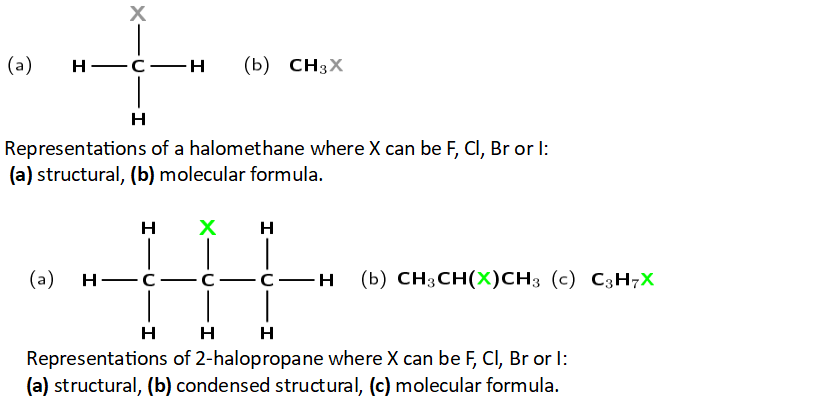

An organic compound is always named in accordance with the longest chain of carbon atoms that contains the functional group. If the substituent is an alkyl group, it is known as a branched chain.
Some uses of haloalkanes include:
- in fire extinguishers
- as aerosol propellants
- in refrigeration
- generating foamed plastics
- solvents in dry cleaning processes (not actually dry, but no water is required).
CFC stands for chlorofluorocarbons. Due to their low toxicity and low reactivity, CFCs were widely used in refrigeration and as propellants in aerosols. However, the low reactivity means that CFCs can get into the upper atmosphere where they are degraded by UV light and damage the ozone layer.
Chloroform ([latex]\scriptsize \displaystyle \text{CHC}{{\text{l}}_{\text{3}}}[/latex]) was used as an anaesthetic for years. However, aside from causing dizziness, fatigue and headaches, it was discovered to be toxic, often fatally so. Even non-fatal doses can cause damage to the kidneys and liver. Chloroform can sometimes be found in cough syrups, although not often anymore.
Summary
In this unit you have learnt the following:
- Organic chemistry is the branch of chemistry that deals with organic molecules. An organic molecule is one that contains carbon.
- All living organisms contain carbon. Plants use sunlight to convert carbon dioxide in the air into organic compounds through the process of photosynthesis. Animals and other organisms then feed on plants to obtain their own organic compounds. Fossil fuels are another important source of carbon.
- It is the unique properties of the carbon atom that give organic compounds certain properties.
- The carbon atom has four valence electrons, so it can bond with four other atoms, often joining to itself resulting in long chain structures. It also forms mostly covalent bonds with the atoms that it bonds to.
- An organic compound can be represented in different ways, such as by a molecular formula, a structural formula, a semi-structural formula or a condensed structural formula.
- A functional group is a particular group of atoms within a molecule, which give it certain reaction characteristics. Organic compounds can be grouped according to their functional group.
- The hydrocarbons are organic compounds that contain only carbon and hydrogen. They can be further divided into the alkanes, alkenes and alkynes, based on the type of bonds between the carbon atoms.
- The alkanes have only single bonds between their carbon atoms and are unreactive. Simple alkanes exist as a homologous series, in which adjacent members differ by a [latex]\scriptsize \displaystyle \text{C}{{\text{H}}_{\text{2}}}[/latex] unit.
- The alkenes have at least one double bond between two of their carbon atoms and the alkynes have at least one triple bond between two of their carbon atoms. They are both more reactive than the alkanes.
- An alcohol is an organic compound that contains a hydroxyl group (−OH).
- The alcohols have several different uses including their use as a solvent, for medicinal purposes and in alcoholic drinks.
- The alcohols share a number of properties because of the hydroxyl group. The hydroxyl group affects the solubility of the alcohols (in water). Those with shorter carbon chains are generally more soluble, and those with longer chains are less soluble.
- A molecule is said to be saturated if it contains the maximum possible number of hydrogen (or other) atoms for that molecule. The alkanes are all saturated compounds.
- A molecule is unsaturated if it does not contain the maximum number of hydrogen atoms for that molecule. The alkenes and alkynes are examples of unsaturated molecules. If a double or triple bond is broken, more hydrogen (or other) atoms can be added to the molecule.
Unit 1: Assessment
Suggested time to complete: 20 minutes
- .
- Name the homologous series of:
[latex]\scriptsize \displaystyle \text{C}{{\text{H}}_{\text{3}}}\text{CH}\left( {\text{C}{{\text{H}}_{\text{3}}}} \right)\text{C}{{\text{H}}_{\text{2}}}\text{CH}\left( {\text{CH3}} \right)\text{C}{{\text{H}}_{\text{2}}}\text{C}{{\text{H}}_{\text{3}}}[/latex] - Give the general formula of:
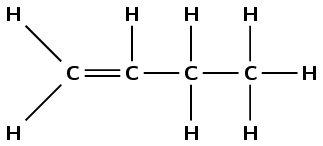
- Name the homologous series of:
- Give two possible structural formulae for the compound with a molecular formula of [latex]\scriptsize \displaystyle {{\text{C}}_{\text{4}}}{{\text{H}}_{{\text{10}}}}[/latex].
- .
- What is the difference between the alkanes, alkenes and alkynes?
- Give the general formula for the alkynes.
- Of the alkanes, alkenes and alkynes which is/are:
- saturated
- unsaturated?
- Which series is the least reactive? Explain why.
- Give the general formula for the haloalkanes with only one halogen atom.
- Draw the structural formulae for:
- [latex]\scriptsize \displaystyle \text{C}{{\text{H}}_{\text{2}}}\left( {\text{Br}} \right)\text{C}{{\text{H}}_{\text{2}}}\text{C}{{\text{H}}_{\text{3}}}[/latex]
- [latex]\scriptsize \displaystyle \text{C}{{\text{H}}_{\text{2}}}\left( \text{F} \right)\text{C}{{\text{H}}_{\text{3}}}[/latex]
- [latex]\scriptsize \displaystyle \text{C}{{\text{H}}_{\text{3}}}\text{C}{{\text{H}}_{\text{2}}}\text{C}{{\text{H}}_{\text{2}}}\text{C}{{\text{H}}_{\text{2}}}\text{OH}[/latex]
- [latex]\scriptsize \displaystyle \text{C}{{\text{H}}_{\text{3}}}\text{C}{{\text{H}}_{\text{2}}}\text{CH}\left( {\text{OH}} \right)\text{C}{{\text{H}}_{\text{3}}}[/latex]
The full solutions are at the end of the unit.
Unit 1: Solutions
Exercise 1.1
- .
- Molecular formula = [latex]\scriptsize {{\text{C}}_{\text{3}}}{{\text{H}}_{\text{8}}}[/latex]
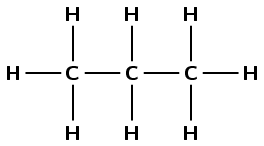
- Molecular formula: [latex]\scriptsize \displaystyle {{\text{C}}_{\text{5}}}{{\text{H}}_{{\text{12}}}}[/latex]
Although the condensed formula was written with the methyl group attached to the third carbon, if we look at the formula from right to left you will see that it is attached to the second carbon and so either of the representations given below are acceptable.

- Molecular formula = [latex]\scriptsize {{\text{C}}_{\text{3}}}{{\text{H}}_{\text{8}}}[/latex]
- .
- Condensed structural formula: [latex]\scriptsize \displaystyle \text{C}{{\text{H}}_{\text{3}}}\text{CHCHC}{{\text{H}}_{\text{3}}}[/latex]
Molecular formula: [latex]\scriptsize \displaystyle {{\text{C}}_{\text{4}}}{{\text{H}}_{\text{8}}}[/latex] - Condensed Structural formula: [latex]\scriptsize \displaystyle \text{C}{{\text{H}}_{\text{2}}}\text{CHCH}\left( {\text{C}{{\text{H}}_{\text{3}}}} \right)\text{C}{{\text{H}}_{\text{3}}}[/latex]
Molecular formula: [latex]\scriptsize \displaystyle {{\text{C}}_{\text{5}}}{{\text{H}}_{{\text{10}}}}[/latex]
- Condensed structural formula: [latex]\scriptsize \displaystyle \text{C}{{\text{H}}_{\text{3}}}\text{CHCHC}{{\text{H}}_{\text{3}}}[/latex]
Exercise 1.2
- An alkene has a double bond; an alkane has single bonds only.
- Unsaturated hydrocarbons have double or triple bonds and are quite reactive; saturated hydrocarbons have only single bonds and are unreactive.
- The alkanes are the least reactive. The saturated bonds are less reactive than the unsaturated double or triple bonds found in alkenes and alkynes.
Unit 1: Assessment
- .
- All the carbon atoms are bonded to the maximum number of other atoms (four) and there are only hydrogen and carbon atoms in the molecule. Therefore this is an alkane.
- [latex]\scriptsize \displaystyle {{\text{C}}_{\text{n}}}{{\text{H}}_{{\text{2n}}}}[/latex]
- .
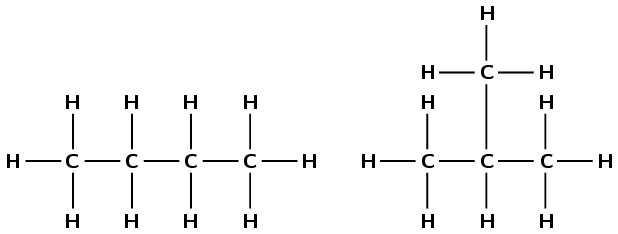
- .
- Alkanes have only single bonds between carbon atoms, alkenes have at least one double bond between carbon atoms and alkynes have at least one triple bond between carbon atoms.
- [latex]\scriptsize \displaystyle {{\text{C}}_{\text{n}}}{{\text{H}}_{{\text{2n-2}}}}[/latex]
- .
- alkanes
- the alkenes and alkynes
- The alkanes are the least reactive. The saturated bonds are less reactive than the unsaturated double or triple bonds found in alkenes and alkynes.
- [latex]\scriptsize \displaystyle {{\text{C}}_{\text{n}}}{{\text{H}}_{{\text{2n}}}}\text{+1X}[/latex] where X is any halogen atom.
- .
- .
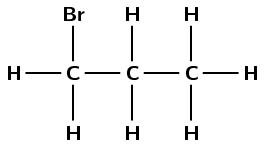
- .
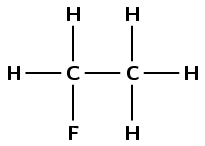
- .

- .

- .
Media Attributions
- Fig 1 © Daviewales is licensed under a CC BY-SA (Attribution ShareAlike) license
- Fig 2 © DHET is licensed under a CC BY (Attribution) license
- Fig 3 © DHET is licensed under a CC BY (Attribution) license
- fig 4 © DHET is licensed under a CC BY (Attribution) license
- Fig 5 © DHET is licensed under a CC BY (Attribution) license
- Fig 6 © Siyavula is licensed under a CC BY-NC (Attribution NonCommercial) license
- Fig 7 © DHET is licensed under a CC BY (Attribution) license
- Fig 8 © DHET is licensed under a CC BY (Attribution) license
- Fig 9 © DHET is licensed under a CC BY (Attribution) license
- Fig 10 © Libre Text is licensed under a CC BY-NC-SA (Attribution NonCommercial ShareAlike) license
- Fig 11 © Libre Text is licensed under a CC BY-NC-SA (Attribution NonCommercial ShareAlike) license
- Fig 12 © Libre Text is licensed under a CC BY-NC-SA (Attribution NonCommercial ShareAlike) license
- Fig 13 © Libre Text is licensed under a CC BY-NC-SA (Attribution NonCommercial ShareAlike) license
- Fig 14 © DHET is licensed under a CC BY (Attribution) license
- Fig 15 © DHET is licensed under a CC BY (Attribution) license
- Fig 16 © DHET is licensed under a CC BY (Attribution) license
- Fig 17 © DHET is licensed under a CC BY (Attribution) license
- Fig 18 © DHET is licensed under a CC BY (Attribution) license
- Fig 19 © Libre Text is licensed under a CC BY-NC-SA (Attribution NonCommercial ShareAlike) license
- Fig 20 © Siyavula is licensed under a CC BY-NC (Attribution NonCommercial) license
- Fig 21 © Siyavula is licensed under a CC BY-NC (Attribution NonCommercial) license
- Fig 22 © Siyavula is licensed under a CC BY-NC (Attribution NonCommercial) license
- Fig 24 © Siyavula is licensed under a CC BY-NC (Attribution NonCommercial) license
- Fig 25 © Siyavula is licensed under a CC BY-NC (Attribution NonCommercial) license
- Fig 26 © Siyavula is licensed under a CC BY-NC (Attribution NonCommercial) license
- Fig 27 © Siyavula is licensed under a CC BY-NC (Attribution NonCommercial) license
- Fig 28 © Siyavula is licensed under a CC BY-NC (Attribution NonCommercial) license
a molecule that contains carbon atoms generally bonded to other carbon atoms and hydrogen atoms, as well as other atoms
a specific group of atoms and the bonds between them, that are responsible for the characteristic chemical reactions of those molecules
compounds which have no double or triple bonds (i.e. they have single bonds only); all carbon atoms are bonded to four other atoms
compounds which contain double or triple bonds; a carbon atom may therefore be bonded to only two or three other atoms
organic molecules which contain only carbon and hydrogen atoms with no other functional groups besides single, double or triple carbon-carbon bonds
a family of organic compounds with the same functional group but different carbon chain length
